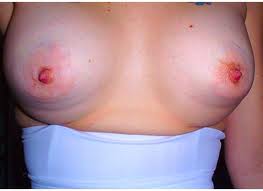The double bubble phenomenon after breast augmentation is not a rare occurrence. Appearing as a result of a crease in the middle of the lower pole of the breast, it is both a visual and palpable breast surface contour deformity. It is often stated that it is the result of disruption of the natural inframammary fold. (IMF) But this simple explanation does not take into account that many breast augmentations need to lower the IMF to avoid having an implant that is positioned too high. Yet most of these patients will not develop the double bubble lower breast pole problem.

In the patient with a naturally high inframammary fold that is recognized before surgery, it is necessary during the procedure to completely release the horizontal fascia connections to the dermis. This is usually done by electrocautery and sometimes even scoring the dermis of the skin may be necessary to efface the residual IMF fold. In some cases the tissue stretching effect of the implant will help stretch the tight abdominal skin, which now makes up the part of the inferior pole of the breast which exists below the residual high IMF. This is where the use of a shaped teardrop or anatomic implant is helpful as by adding more volume to the lower pole of the breast, a tissue expander effect is created.
In patients who have developed a double bubble after their breast augmentation who had an IMF at the correct level initially, the problem is that the implant has become displaced downward. In these cases, the implant is always in the submuscular position and the pressure of muscle contraction displaces the implant downward into a new pocket below the IMF. This can generally be improved by eliminating this undesired pocket space by sewing it together with permanent braided sutures. By moving the implant back up higher, the amount of forces generated on the implant by the pectoral muscle is lessened. One usually wears an underwire after surgery for 6 to 8 weeks after surgery to protect this suture plication.
If the breast tissues are thin, this lower pocket obliteration can be reinforced with any of the commercially available acellular dermal matrixes. Due to their expense, their use is often reserved for those patients who have failed an initial capsular plication/implant elevation. The use of these acellular matrixes is having a growing role in breast implant revision surgery through is tissue support capabilities.
Dr. Barry Eppley
Indianapolis, Indiana


